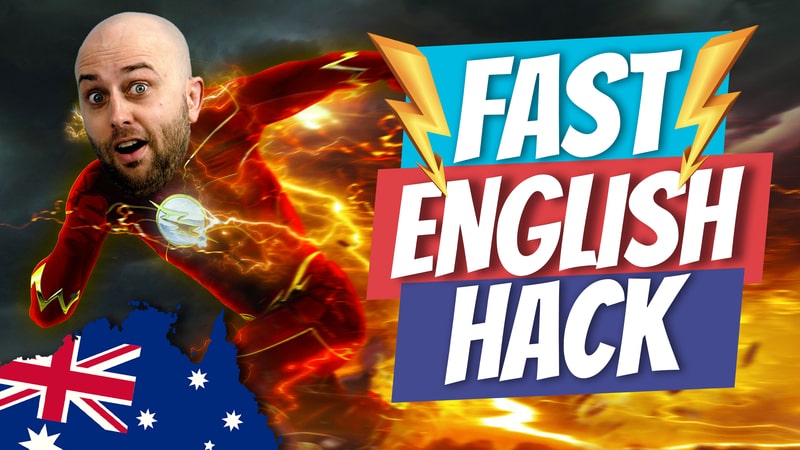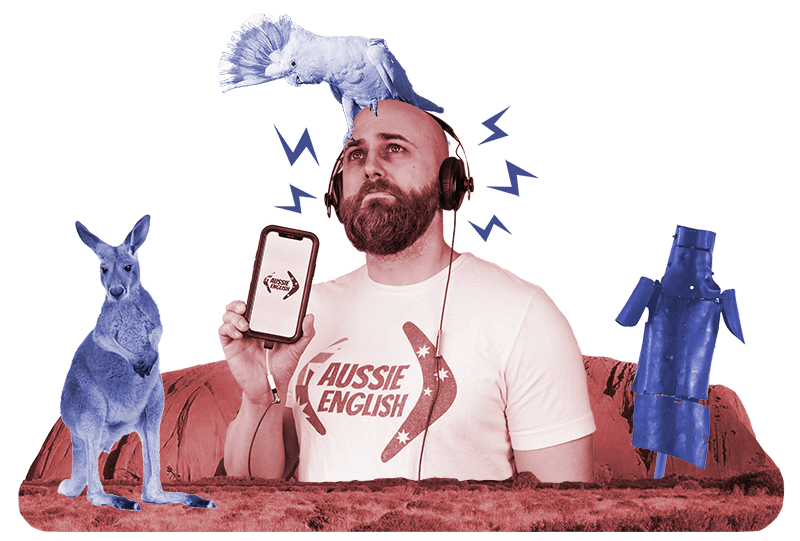
AE 970
Australian Pronunciation Lesson | How To Contract TO BE
Learn Australian English in this
Advanced English Pronunciation Lesson!

In today's episode...
When speaking, native English speakers tend to shorten or contract words.
In this case, the auxiliary verbs AM, IS, and ARE can be contracted with pronouns without changing their meaning.
Mastering these contractions will make you sound more natural. You will also gain a better understanding of what native speakers are trying to tell you.
First, I will teach you the correct pronunciation for the auxiliary verb (am, is, are) and the pronoun.
You will learn how each of them should be sounded out when they are contracted together.
There will be three examples provided for each contracted pair of the auxiliary verb + pronoun.
Find a good spot where you can practice your pronunciation. Focus on how the sounds change and pay attention to the intonation.
Let’s get into this!
Contraction #1: Am I
Contraction #2: Are You
Contraction #3: Is He
Contraction #4: Is She
Contraction #5: Are We
Contraction #6: Are They
Contraction #7: Is It
So, how did it go for you?
Did you get to the end of this lesson?
Check out this link right NOW! 👉👉👉 https://www.aussieenglish.com.au/apc33
Improve your listening skills today – listen, play, & pause this episode – and start speaking like a native English speaker!

Watch & listen to the convo!
Listen to today's episode!
This is the FREE podcast player. You can fast-forward and rewind easily as well as slow down or speed up the audio to suit your level.
If you’d like to use the Premium Podcast Player as well as get the downloadable transcripts, audio files, and videos for episodes, you can get instant access by joining the Premium Podcast membership here.
Listen to today's episode!
Use the Premium Podcast Player below to listen and read at the same time.
You can fast-forward and rewind easily as well as slow down or speed up the audio to suit your level.
Transcript of AE 970 - Australian Pronunciation Lesson | How To Contract TO BE
G'day, you mob! Pete here from Aussie English, and this is the number one place for anyone and everyone wanting to learn Australian English, man, I am excited because today this episode is about one of my favourite subjects, as you can tell, because I've had too much caffeine and I am talking quickly, Fast Spoken English, how to understand fast spoken English, but also more importantly, how to do it yourself. So that when you're speaking English, you sound much more natural. Okay, we don't sort of sound like robots. Hello. I'm a robot. Not simple. Just saying one word after the other. In English, we contract words. There's a lot of things going on. There's a lot of sound changes. So mastering these is going to help you sound much more natural when speaking.
So today we're going to look at the auxiliary verbs AM, ARE, and IS and how these contract down to pronouns like I, They, and You when speaking English quickly. Are you aware of it? Is it worth learning? As you'll see in this episode? It's definitely worth learning because it's going to help you understand native English speakers and advanced English speakers. So your listening comprehension is going to improve and then it's also going to help you sound like them yourself when you speak English.
Ok, so in this lesson, I'm going to break down the auxiliary verb and the pronoun and how that's pronounced when we make a few subtle changes by contracting things together. And then after each of these, I'll go through three example sentences that I want you to listen to and then repeat, ok? So find some way that you can speak out loud so that you can practise your pronunciation. Focus on the contractions that I'm making, the way that these sounds are changing. And also because these are questions, focus on the intonation. There's going to be some rising intonation. Tails, at the ends of these sentences, ok?
Before we get into it, though, don't forget, make sure that you stay right until the very end, because I have a secret weapon, a little bit of secret sauce. A little gift for you guys that is going to help you level up your English pronunciation lightning fast. Alright. Are you ready? Let's go.
So number one. Am I. Now, this goes through quite a few changes. Am I. Firstly, we can connect the M in the auxiliary verb AM to the I vowel sound. æm‿ɑe, right? That M sound goes to the next syllable æm‿ɑe æm‿ɑe. After this, we can turn the "eh" sound in the auxiliary verb AM into a schwa sound ə, ok? So you're going to hear əˈmɑe əˈmɑe. And we covered this in previous lessons on the auxiliary verbs do and have. Ok, you can check these out up above here.
The next step, and I really didn't know how to transcribe this into the IPA, into the international phonetic alphabet, is that the schwa sound can actually completely disappear. And you're going to hear this syllabic M sound in front of 'mɑe'.
So this is sort of complicated linguistic speak for having the mouth closed in an M position, and vocalising it. So going Mmm Mmm. And then saying 'mɑe'. So you may hear people from time to time saying mm mɑe mm mɑe, right. It's like they've just, just reduced that m̩ˈmɑe, stop saying the schwa, and they've just gone straight to m̩ˈmɑe, like they've closed their mouth for the schwa sound. m̩ˈmɑe m̩ˈmɑe.
So let's go through some example sentences. Am I coming, too? Am I coming, too? Am I going to learn anything? Am I going to learn anything? Am I the only one? Am I the only one?
Number two. Are you. Are you. And you will notice in Australian English, is there a rhotic R sound in the auxiliary verb ARE. You hear it? Or do you not hear it? When I pronounce that word? ɐ, look at my tongue. ɐ. Australian English is non rhotic. So we only say the ɐ sound in these words when there's a vowel sound after them. So in the case of 'are you' mean I'd say the ɐ. Are you.
So the first and only step to contracting ARE and You is turning ARE into a schwa sound. Right. We reduce it. It's unstressed so it becomes the schwa jʉ jʉ. əˈjʉː əˈjʉː and you may even hear YOU becoming jʉ as well where the "oo" vowel sound in YOU has become a schwa. So you may hear əˈjʉː əˈjʉː In fact, I'd probably say that, to be honest, yeah, əˈjʉː əˈjʉː. You'll see why in a sec, ok? Sounds weird. Let's listen to it in context.
Are you leaving? Are you leaving? Are you working today? Are you working today? Are you going for a walk? Are you going for a walk? So it could be either, ɐː jʉː Are you going for a walk? Or əˈjʉː Are you going for a walk?
Number three. Is he. With the word HE, the H disappears, right. When we link this together, especially when there's a Z or another consonant sound before that H you're going to hear ɪz hiː, right? ɪz hiː there's no H sound. It's H deletion. It's gone. It's been deleted. ɪz hiː ɪz hiː.
The next step, like we did previously, is we put that schwa in in place of the auxiliary verb vowel. So you're going to hear əˈziː əˈziː əˈziː The last thing here that's really interesting is that sometimes we can actually completely get rid of that schwa sound and you're just going to hear ziː ziː It's kind of like the æm ɑe and the mɑe. ziː ziː.
Let's go through some examples, I'll say them once with əˈziː and then the second time with ziː. Is he at home? Is he at home? Is he from Australia? Is he from Australia? Is he asking for help? Is he asking for help?
Number four. Is she. Is she. So the first step here, because we have that Z sound next to the sh sound, ɪz ʃiː ɪz ʃiː - it's really hard to do that. ɪz ʃiː - especially fast. ɪz ʃiː ɪz ʃiː And say both. ɪ‿ʃiː we get rid of the Z sound. So you just going to hear ɪ‿ʃiː ɪ‿ʃiː ɪ‿ʃiː.
The next step is turning that ə vowel sound from the word IS into a schwa. əˈʃiː əˈʃiː Now we could just say 'she' and then whatever the phrase is after that, but because none of that auxiliary verb is left, sort of smashed into the word that is 'she', it's not really contraction. It is, I think, elision where we've just removed the auxiliary verb IS from the sentence. Right.
So an example might be: Is she a model? Is she a model? So we've contracted there, if we just get rid of the word IS, you could say "She a model?" "She a model?" Where it's elision. OK, so they are sort of different, but we're talking about contractions today. Second example: Is she travelling at the moment? Is she travelling at the moment? Is she going for a run? Is she going for a run?
Number five. Are we. Remember that R, no R sound, as in ɐː There's no R in ɐː There is when I say it like that, though. "R in ɐː" Confusing, Australian English, huh? ɐː wiː ɐː wiː So the first and only thing that we do here is turn ARE into a schwa. əˈwiː əˈwiː Are we late? Are we late? Are we going to be invited? Are we going to be invited? Are we catching the train? Are we catching the train?
Six. Are they. Are they. Similar to the one before, there's only one step here and it is turning ARE into the schwa so that you'll hear əˈðæɪ əˈðæɪ Are they your friends. Are they your friends? Are they playing soccer? Are they playing soccer? Are they at home? Are they at home?
Number seven, the last one, guys! Is it. Is it. First step, the ɪz sound joins to that vowel sound ɪt. ɪz‿ɪt ɪz‿ɪt I don't know why I'm doing this, but it feels like that's what I need to be doing. ɪz‿ɪt ɪz‿ɪt The next step is turning the E in the word IS into a schwa. əˈzɪt ː əˈzɪt ː The next step we could potentially turn the E sound in IT into a schwa as well. So you may hear just zɪt zɪt.
And then also, or, not "and then". More, "either or", right. We could also do what happened with IS HE when it became just ziː, we could say zɪt zɪt.
Ok, so the most natural ones here, I think that I would say there might be three. ɪz ɪt, əˈzɪt ː, and zɪt. Ok, I'm going to say these phrases naturally without thinking about it, and we'll just see how I say it. OK, so no preparation beforehand. I'm not staging it.
Is it snowing? Is it snowing? So there I've said, əˈzɪt ː Two schwas. Is it snowing? I could say "zɪt snowing outside?" So just zɪt zɪt, not even zit. Is it snowing outside? It's almost like I'm just saying, 'is it' 'is it' so quickly that I've just gotten rid of that schwa at the start. zɪt snowing outside? Is it a long way away? Is it a long way away? Is it going to change anything? Is it going to change anything?
So there you go. That's something we can end on, right? It's really interesting that this sort of level of contraction in these phrases, it can vary. And native speakers, like myself, may use multiple different kinds, right? If we're really contracting everything together, you might hear things like "zɪt snowing outside?" But then if we're speaking a little more slowly or in, say, maybe a more formal situation, we may not contract it as much. "Is it snowing outside?" So all sorts of things like that can happen when speaking English. It's good to be aware of them and it's good to be able to do them, ok.
So before I tell you about my special gift for you today, let's recap what we have gone through. Ok, so I'm going to say the auxiliary verbs and the pronouns and how they get contracted together, I'll give you one of the examples and we go through all of them and then we'll go through a little phrase for each of them for you to practise one more time. Okay. You ready? Let's go.
Am I. əˈmɑe Am I going to see a koala?
Are you? əˈjʉː Are you going to see a koala?
Is he? əˈzi ː Is he going to see a koala?
Is she? əˈʃiː Is she going to say koala?
Are we. əˈwiː Are we going to see a koala?
Are they? əˈðæɪ Are they going to see a koala?
Is it? əˈzɪt ː Is it going to see a koala?
So there you go, guys, I hope that helped. I hope you can now hear and understand fast spoken English, but more importantly, I hope you can say it yourself, ok?
If you would like to take your pronunciation to the next level, if you want to master things like the IPA, the International Phonetic Alphabet, which is what I think is the secret weapon to improving your pronunciation by yourself. If you also want to nail all the different vowel sounds in Australian English and all of the different consonant sounds in Australian English, then I recommend that you go and check out my Australian Pronunciation Course.
There'll be a special link in the description today where for the next twenty four hours after this video and podcast has been published, you can sign up for 33% OFF the normal price. Ok?
And lastly, I recently added an extra 25 Advanced Pronunciation lessons for you to complete after you've mastered the different sounds in Australian English. These are things covering the Syllabic L, the Syllabic N, different Connected Speech, Consonant Clusters, How Sounds Disappear. The Australian R sound. There are loads of things in there. Little nuggets, little secret tips for you to learn so that you sound much more like an advanced English speaker when speaking English. Go figure. Anyway, I'm Pete, this is Aussie English. Thank you so much for joining me and I will see you next time. See yeah!

Listen & Read with the Premium Podcast Player
Get more out of every episode!

Premium Podcast members get access to...
- All 900+ podcast episodes including member-only episodes
- Member-only episode video lessons
- Downloadable transcript PDFs & audio files for every episode

Recent Episodes:


AE 1299 – Pete’s 2c: Do You Ring, Call, or Dial Someone on the Phone in Australia?

AE 1298 – Learn English with a Short Story: Day at the Beach

AE 1297 – The Goss: How ‘Dropping In’ Culture Has Changed in Australia

AE 1296 – The Goss: Gorilla Glasses & Dad’s Crazy Zoo Stories – MEMBERS ONLY

AE 1295 – The Goss: Australia’s Most & Least Ethical Jobs

AE 1294 – The Goss: Australia Just Had the Best Aurora in 500 Years!

AE 1293 – The Goss: Should Aussie Schools Ban Homework?

AE 1292 – How Aussie Do Asian Australians Feel? r_AskAnAustralian

Share

Join my 5-Day FREE English Course!
Complete this 5-day course and learn how to study effectively with podcasts in order to level up your English quickly whilst having fun!

Join my 5-Day FREE English Course!
Complete this 5-day course and learn how to study effectively with podcasts in order to level up your English quickly whilst having fun!


Want to improve a specific area of your English quickly and enjoyably?
Check out my series of Aussie English Courses.
English pronunciation, use of phrasal verbs, spoken English, and listening skills!

Have you got the Aussie English app?
Listen to all your favourite episodes of the Aussie English Podcast on the official AE app.
Download it for FREE below!



Want to improve a specific area of your English quickly and enjoyably?
Check out my series of Aussie English Courses.
English pronunciation, use of phrasal verbs, spoken English, and listening skills!
Leave a comment below & practice your English!






Responses